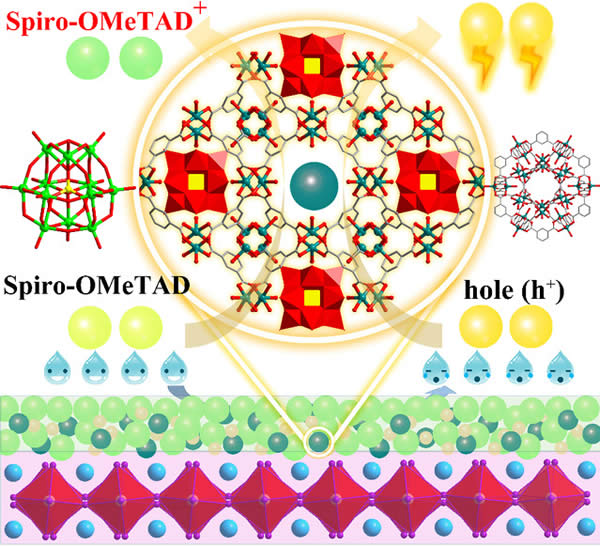
Recently, the optoelectronic functional materials team led by Professor Yang Yulin and Professor Fan Ruiqing of the School of Chemical Engineering and Chemistry of our school has made important progress in the field of perovskite photovoltaics, and the research results have been published in the form of scientific papers in the top international chemistry journal Angewandte Chemie International Edition , Impact factor 12.275), and selected as "Hot Paper". The title of the paper is "Self-Assembly of Hybrid Oxidant POM @ Cu-BTC for Enhanced Efficiency and Long-time Stability" of Perovskite Solar Cells DOI: 10.1002 / anie.201909291), Professor Yang Yulin and Professor Fan Ruiqing are the corresponding authors of the article. Our 2017 doctoral student Dong Yayu and the postdoctoral teacher Zhang Jian are co-first authors, and our school is the only communication unit.
The photoelectric conversion efficiency (PCE) of perovskite solar cells (PSCs) has been rapidly improved in recent years, and the current certified conversion efficiency has reached 25.2%. Nevertheless, the actual production and application of perovskite solar cells are still limited by the stability of the device. Based on the problem that the conductivity and hole mobility of the organic molecule Spiro-OMeTAD hole transport layer material is still low, and it takes a long time to reach the oxidation state, the research group proposed to combine the porosity and multimetal of metal organic frameworks (MOFs) The advantage of the oxidation ability of oxyacid salts (POMs), the porous composite material POM @ Cu-BTC is applied to the hole transport layer of PSCs to improve the oxidation efficiency of the Spiro-OMeTAD molecule and the electrochemical performance of the hole transport layer material. The results show that the POMs in the structure can oxidize Spiro-OMeTAD quantitatively and controllably in an inert atmosphere, and the conductivity and hole mobility of the doped HTM film are increased to nearly twice that of undoped, the prepared perovskite The solar device achieved a PCE of 21.44%, and the fill factor was as high as 0.80. In addition, after one month of storage at room temperature of 30% relative humidity, the unencapsulated battery device can still maintain 90% of the initial PCE. Therefore, this research work proposes a simple chemical doping strategy, that is, the hybrid material combined with oxidized POMs and porous MOF is introduced into the hole transport layer, which not only realizes the quantitative and controlled oxidation of Spiro-OMeTAD, but also improves the conductivity of the film. The rate and hole mobility, and the long-term stability of the device have also been significantly improved, which is of great significance for the industrial development of perovskite solar cells.
Professor Yang Yulin and Professor Fan Ruiqing have been engaged in the research of photovoltaic devices and MOF materials for many years. They have been in "Adv. Energy Mater. Impact Factor: 24.88", "Material Chemistry A" (J. Mater. Chem. A, Impact Factor: 10.73), "ACS Appl. Mater. Inter. Impact Factor: 8.45", (ChemSusChem, Impact Factor: 7.8) and other journals published more than 50 research results. (Text / Photo of College of Chemical Engineering and Chemistry)
The most common applications that machine screws tend to be used for involve metal parts and panels needing to be fixed securely together. This is a daily requirement across all manner of industrial, manufacturing, construction, assembly, process, and production environments.
How do you use machine screws? Simply put, you use machine screws in much the same way as you would use any other type of screw or bolt.
Follow the below steps for guidance on using machine screws:
You use a machine screw by drilling or tapping it into a pre-drilled hole or nut, using either a manual or powered screwdriver
Power tools are frequently associated with the use of machine screws. This is because fasteners of this type are typically demanded in more heavy-duty or industrial-scale assembly and construction jobs
In the vast majority of scenarios, machine screws will be used with a nut and driven into a pre-drilled (tapped) hole. When using a nut with a machine screw, the nut will typically go behind the rearmost component or part being fastened
Machine screws are versatile and are often used to join two or more different parts or components. Sometimes, they are also chosen to hold down or sandwich gaskets and membranes, as well as being used on terminal strips and for making numerous other sorts of electrical connections
A handy alternative use for machine screws is to separate and secure parts or panels which need to be kept at a fixed distance from one another. This is achieved via a type of threaded coupling which allows two machine screws to be driven in from opposing directions. The separation distance you require between parts will dictate the length of the coupling inserted between the two fasteners
Machine Screw,Countersunk Machine Screw,Self Tapping Machine Screws,Stainless Steel Machine Screws
Taizhou Risco Stainless Steel Products Co.,Ltd , https://www.riscofastener.com